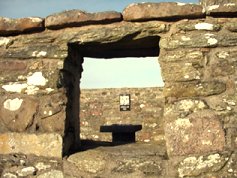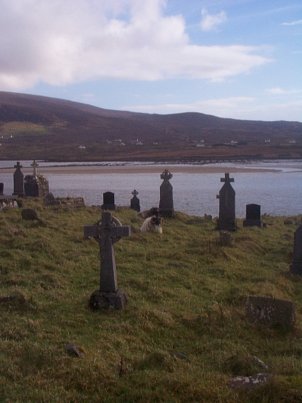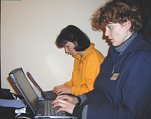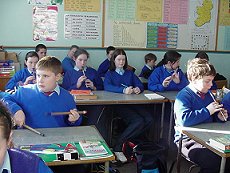 Shared
Landscapes
Shared
Landscapes
We made a small trip round the island under the very pleasant guidence
of Willem van Groor. A the beginning, he told us a lot about the place
around the Deserted Village and Achill, how people have lived in this
countryside for a long time, beginning with the Mesolithic age (6000-4000
BC). This was documented by so-called "midden" or shell mounts,
where people came for several years to eat what they had gathered, fished
or hunted. The hills layers of shells and fishbones change with charcoal
and got a height of some metres.
During the neolithical time (4000-2000BC), people learned farming and had cattle. It is certain that those people still settled around Slievemore. A group of Megalith Tombs on the south face of Slievemore can still be visited today.
There is very little information about the Bronze Age (2000-300BC). However,
from the Iron Age and early Christion period (ca 300BC-1100 AD), they
found settlements on Achill marked by the remains of promontory forts,
cashels and crannogs. Cashels are ring forts of stone built as protected
enclosures around farmsteads (500-1100AD); and crannogs are islands made
artificially by building pallisades of oak and filling them up with stones.
During that time, a Celtic tribal society emerged with chieftrains ruling
over free farmers and tributory clan members.
Pastoral farming was important, wealth was measured by cattle.
Archaeologists suggest that the buildings of the period had been of the
clachan type, round in plan with a domed exterior and built entirely of
cobelled stonework without mortar.
People of the village of Dugort, an example of a "Clachan", in use for over 3 centuries, had a "Rundale"system of agriculture, because the fields did not have an enclosure. In summer, their cattle was brought to the hills, where some members of the families lived in small booley villages with small oval stone buildings, which might be the precurrent use of the place of the Deserted Village, too. At that time, the lands were rented to the community by the landlord, the community determined the amount of rent to be paid by each household. As long as the population remained stable, it worked sufficiently. But with the potato a rapid population growth caused the crash of this system, because the plot could no longer be divided emong the more and more surviving children.
When times changed, the land was re-distributed to the tenants in the marginal or upland areas; the holdings were carved into long stripes, each stripe containing a variety of land types to be seen round the island. Therefore the old clachan form was replaced by seperate dwellings or linear villages like the Slievemore Deserted Village.
We passed the Achill Mission, that was established in the 1830s by Edward Nangle to help starving people. Because the nutrition of the population depended only on the potato, a crop failure of some following years had enormous effects for the people, and that happened more than one time from 1724 until 1845, when the Great Famine started.
We had a short walk on the beach of Dughort. But we could not reach the
place of the Childrens' Graveyard because of water. It is situated on
a cliff edge which the sea is destroying time by time. Unbaptised children were burried there.
Unbaptised children were burried there.
Then we stopped at a place where we could see conserved roots of fire trees in the peat, which show that the whole region had been covered with wood in former times. Because the trees were burned, the charcoal took off the oxygen of the water, so it became acid. Trees could live there no longer - and the rest died also. The peat started to grow within 1000 years till today.
On the way back we had a look at a small lake, Lough Anascaddy, where a crannoch has survived, an artificial island made by people who lived on it in order to be safe against their enemies.
At last we had a look at the typical fisherboats, the currachs, a traditional fishing craft of the west of Ireland. The boat is coated with tar, covered with cloth of light timbered construction. It has no keel but is provided with three longitudinal timbers to act as runners when the currach is being launched. In former times the boats were rowed by paddels, today they are propelled with outboard engines.
 All
the activities were focused to the highlight of the day: The final presentation
in Achill Cliff House. Our last activities for the presentation was to
visit the IT CENTRE where we printed our little poems and essays. Furthermore
we organised the screen for the PowerPoint presentations. After
dinner the final presentation of all the workshops of the Connect participants
and guests from Achill Island started. Impressing pictures were shown
accompanied by recitals of poems composed by the participants. We said
special thanks to Sean Cannon who wasn't able to join us that evening.
He inspired us to shoot the best pictures of our life and to be creative
in an extraordinary way.
All
the activities were focused to the highlight of the day: The final presentation
in Achill Cliff House. Our last activities for the presentation was to
visit the IT CENTRE where we printed our little poems and essays. Furthermore
we organised the screen for the PowerPoint presentations. After
dinner the final presentation of all the workshops of the Connect participants
and guests from Achill Island started. Impressing pictures were shown
accompanied by recitals of poems composed by the participants. We said
special thanks to Sean Cannon who wasn't able to join us that evening.
He inspired us to shoot the best pictures of our life and to be creative
in an extraordinary way.
Today is the big day. Tonight, we are supposed to present what we have worked at all week. But shock and horror! One member of our group left us. Now what? Luckily, we are able to recruit two men who are fast learners. Whew. Lucky us. The dress rehearsal didn't go too well. Oh boy. But isn't that usually a good sign? Well, it was. We sang our little hearts out that night and got a big round of applause for our song about Achill Island. Thank you, everybody!
Time flies when you are together with friends-the last day of our music workshop
I arrived just in time at our cottage for the last day
of our workshop. Just before I took the chance to visit a primary school
where Maria invited me to. It was one of the ten schools where Maria gives
tin whistle lessons. She practices music pieces with the children and
especially at these lessons they practiced some for St. Patrick`s Day
(17th March).  It
was amazing to hear the mass whistles and it was also amazing to see what
you can do in the meantime with a whistle when Maria introduced them into
a new music piece. After the lessons during a conversation with the head
of the school I get to know how important the traditional music for the
Irish is and that they are happy about Maria and her engagement in this
school. Now back to the workshop: For the last time we went through our
music pieces we planned to present at the farewell party in the evening.
It
was amazing to hear the mass whistles and it was also amazing to see what
you can do in the meantime with a whistle when Maria introduced them into
a new music piece. After the lessons during a conversation with the head
of the school I get to know how important the traditional music for the
Irish is and that they are happy about Maria and her engagement in this
school. Now back to the workshop: For the last time we went through our
music pieces we planned to present at the farewell party in the evening.
All in all after this week I like to resume that I will never forget these days on Achill Island we had together with Maria, Sarah, Shuna, Bill and Richard. Thanks to them that I could learn so much about traditional Irish music and instruments. Hopefully we will meet again some day to play music together. And that is what I would like to give to them: "May the road rise to meet you, may the sun be always on your side, and until we meet again may God hold you in the palm of his hand."
Friday Finale
It was a lovely
day, Friday the 9 th February, 2001
In the evening after dinner Linda thanked the restaurant owners and their
staff for the excellent hospitality and the delicious meals and thanked
them with a bouquet of roses. Finally we came to the "Grand Finale"
The Swedish group
Inger and Daniel opened the Farewell Party with delicious snacks. What
about the Swedish project "Secret Friends"? They decided not
to tell us who our secret friends had been. It was a wonderful idea because
everyone enjoyed the different gifts from his/her own secret friend.
The top event of the evening started with the presentation from each workshop group:
The Anthropology Workshop gave information about life 150 years ago in the deserted villages and showed photos. St. Bridget built the first Christian Church in Ireland.
The Gaelic Workshop: Jenny presented the Gaelic workshops' activities: The highlight was a speech in the Gaelic language. Each member of the group got a little stone with their first name written in Runes.
People from Keel came and thanked everyone for the good time they had working together. Ms. Sheila McHugh spoke some deeply felt sentences about foreigners in Ireland and expressed warm feelings about our stay in Keel.
School Workshop: The presentation of this workshop culminated in traditional music. A mixed group sang.
Our Sea - Your Sea Workshop:
Daniel pointed out the meaning of the sea to Achill Island's habitants.
Shared Landscapes Workshop:
Fredrik presented impressions of Achill Island with historical details.
Photography Workshop- from photos to words:
Magnus presented this topic. The photos are so wonderful and the words
for the background.
Music Workshop: Sylvia's group presented some Irish jigs and the poem "Rose in the Heather". In addition they presented the EU-Train-Song.
Painting Workshop (with Joseph) in Collaboration with Creative Writing Workshop:
 The
auction of O’Donnell’s original paintings was presented in a very dramatic
way. The paintings were not the originals, the police arrested the auctioneer
and B O'D's ex-wife destroyed a picture with a knife. The big painting
was cut into a lot of pieces and each member of the Farewell-Party got
a piece as a memory.
The
auction of O’Donnell’s original paintings was presented in a very dramatic
way. The paintings were not the originals, the police arrested the auctioneer
and B O'D's ex-wife destroyed a picture with a knife. The big painting
was cut into a lot of pieces and each member of the Farewell-Party got
a piece as a memory.
Thanks a lot to the creative writing team for giving us such an entertaining end to the presentations.
Sheila McHugh thanked everyone warmly for coming to Achill Island: "They came as foreigners and went as friends”, followed by a serious poem about friendship.
Gerlinde Kuehn and Peter Pergand

